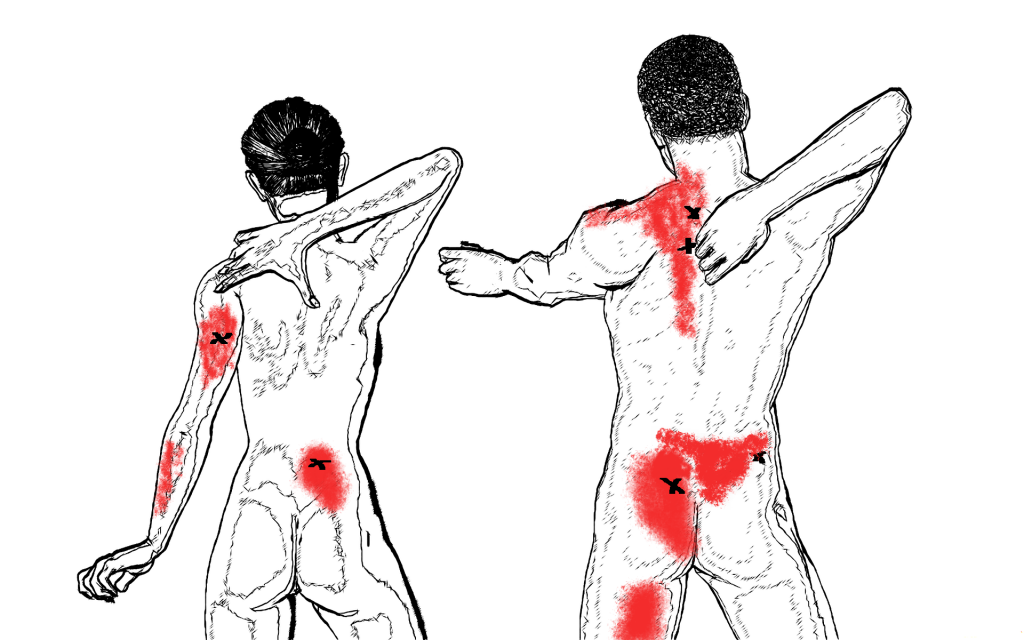WHAT ARE MYOFASCIAL TRIGGERPOINTS?
In the Western world myofascial trigger points as a source of pain became known since the 19th Century. You may have heard of the Valleix points. Valleix (1807-1850) described those points i.e. as various points in the course of a nerve painful to pressure where the nerve emerges from the bony canal or where it penetrates a muscle or aponeurosis. In 1902 Cornelius called them ´nerve pressure points´ and suggested a ´nerve pressure massage´ for their treatment. In my medical training they were called ´myogelosis, a hardened area or nodules within a muscle with no meaning, but often painful during checkup. Until today, their pathophysiology is not totally revealed by science. It is known that in trigger point areas of the muscles the pH is acidic and signs of inflammation are present. Over time hypersensitivity can occur due to changes in the sensory neuronal network.
From studying the latest literature on trigger points and fascia I believe that trigger points are part of fascia becoming dehydrated due to overuse, repetitive motion and injury including micro injury due to physical activities or permanent higher muscle tension caused by permanent emotional stress or anxiety. Dehydration and injury cause adhesions in the connective tissue fibrous structure in the fascia which further alters hydration and the supply of the muscle cells with nutrients and oxygen. The result is a change in metabolism and related lack of energy. All factors together lead to acidity and inflammation. Here, the body is not capable to repair itself, and needs help. Animals will immediately start to rub their bodies and stretch and re-hydrate their fascia and muscles.
However we name myofascial trigger points, their outstanding characteristic is that they are able to cause pain in areas far away from where we can palpate them, which is known as referred pain. They can even cause pain on the other side of the body.
In a muscle, a trigger point complex consists of a taut hardened band with a collection of small trigger points in the centre and many small trigger points around the tendinous insertion. During palpation, trigger points often create a so-called ´jump sign´. In most cases a trigger point complex causes decreased range of motion and muscle weakness, which in the long terms will compress the related joints and intervertebral discs and cause degenerative diseases such as arthritis and spondylosis, but also intervertebral disc hernia or knee meniscus injuries. Trigger point areas can develop over years.

Trigger points are classified as active or latent.
Active trigger points create persistent pain symptoms. Latent trigger points are mainly found in shortened muscles with decreased range of motion of the joints and the spine. They can become activated through muscle overuse, repetitive motion, exposure to cold and often as an effect of an activated immune system which we experience as muscle aching during a flu or flu like cold.
THERAPY OF TRIGGER POINTS
Over the years several therapies have been developed.
In Northern America, the so-called ´Spray and Stretch´ technique is applied very often. The therapist uses ice spray to cool the muscle area which is then stretched. Another technique is dry needling or trigger point acupuncture. Some trigger areas and points overlap with acupuncture points. Here, acupuncture needles are placed in to the trigger points which would cause a change in muscle tension and metabolism. It might also be that the new micro injury caused by the needle supports the change in metabolism. Other doctors inject local anaesthetics such as procaine or lidocaine in to trigger points. In the Far East, certain massages techniques were developed using tools which create pressure on a trigger point for its resolution. Modern techniques such as myofascial release, Rolfing, or a deep sports massage are also used to treat trigger points.
Every serious therapist should have read this groundbreaking book: Janet G. Travell & David G. Simons’ Myofascial Pain and Dysfunction: The Trigger Point Manual, Volume 1+2.
In my practice I have been using the Trigger Shockwave Therapy (TST) for nearly 20 years now. TST was developed by Dr Wolfgang Bauermeister from Munich, Germany. Compared to other trigger point therapies TST is save and non-invasive. It is very often more effective than other therapies because the shock wave can reach deeper trigger point areas than other methods.
SUMMARY
The main cause of musculoskeletal pain syndromes is trigger points (TP). For example, TPs in the gluteus minimus muscle can even mimic the symptoms of sciatica. Treatment of TPs includes general reduction of tissue acidity and inflammation, reduction of emotional tension and the application of effective physical methods, i.e. TST to resolve the TPs. It should always be combined with tissue rehydration techniques such as the MELT method in addition to other necessary chiropractic and physiotherapeutic methods, exercise and diet.
